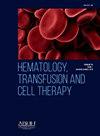PET/CT WITH 68GA-FAPI46 FOR THE DETECTION OF PRIMARY AND METASTATIC LESIONS IN PATIENTS WITH DIFFERENT TYPES OF CANCER. INITIAL EXPERIENCE
IF 1.8
Q3 HEMATOLOGY
引用次数: 0
Abstract
Introduction/Justification
Fibroblast activation protein (FAP), a transmembrane glycoprotein, is over expressed by cancer-associated fibroblasts in the tumor microenvironment. Radiolabeled fibroblast activation protein inhibitors (FAPI) are currently being investigated for PET imaging.
Objectives
To evaluate the diagnostic efficacy of PET/CT with fibroblast activation protein inhibitor (FAPI) labeled with gallium 68 (68Ga-FAPI46) for detecting primary and metastatic lesions in patients with different types of cancer.
Materials and Methods
Patients with different types of cancer confirmed by histopathological study were evaluated with PET/CT with 68Ga-FAPI46 for initial staging or to detect tumor recurrence. The results of PET/CT were compared to the findings of conventional imaging methods such as computed tomography and magnetic resonance imaging and with FDG PET/CT and anatomopathological studies.
Results
Thirty patients were evaluated, twenty two of whom were diagnosed with lung carcinoma, five with soft tissue sarcoma, one patient with each of the following tumors: gastric, breast and neuroendocrine carcinoma. High expression of FAPI was observed in most primary tumors. The diagnostic performance was high due to a favorable physiological organ distribution and low background signal leading to the detection of most metastatic lesions especially in lymph nodes, pleura, peritoneum, skeleton, liver and central nervous system. By contrast, there was false-positive 68Ga-FAPI46 uptake in inflammatory and infectious processes.
Conclusion
PET/CT with 68Ga-FAPI46 is a promising imaging modality for the detection of primary and metastatic lesions of many types of cancer.
68ga-fapi46 Pet / ct用于不同类型肿瘤患者原发及转移病灶的检测。最初的经验
成纤维细胞激活蛋白(FAP)是一种跨膜糖蛋白,在肿瘤微环境中由癌症相关成纤维细胞过度表达。放射标记成纤维细胞活化蛋白抑制剂(FAPI)目前正在研究用于PET成像。目的评价68镓标记的成纤维细胞活化蛋白抑制剂(FAPI) (68Ga-FAPI46) PET/CT对不同类型肿瘤患者原发和转移病变的诊断价值。材料与方法对经组织病理学证实的不同类型肿瘤患者,采用PET/CT对68Ga-FAPI46进行初步分期或检测肿瘤复发。将PET/CT结果与计算机断层扫描和磁共振成像等常规成像方法的结果进行比较,并与FDG PET/CT和解剖病理学研究结果进行比较。结果本组共30例患者,其中肺癌22例,软组织肉瘤5例,胃癌、乳腺癌、神经内分泌癌各1例。FAPI在大多数原发肿瘤中高表达。由于良好的生理器官分布和低背景信号,大多数转移灶均可检出,尤其是淋巴结、胸膜、腹膜、骨骼、肝脏和中枢神经系统。相比之下,在炎症和感染过程中出现假阳性的68Ga-FAPI46摄取。结论68Ga-FAPI46 pet /CT对多种类型肿瘤的原发和转移性病变的检测具有较好的应用前景。
本文章由计算机程序翻译,如有差异,请以英文原文为准。
求助全文
约1分钟内获得全文
求助全文
来源期刊

Hematology, Transfusion and Cell Therapy
Multiple-
CiteScore
2.40
自引率
4.80%
发文量
1419
审稿时长
30 weeks
 求助内容:
求助内容: 应助结果提醒方式:
应助结果提醒方式:


